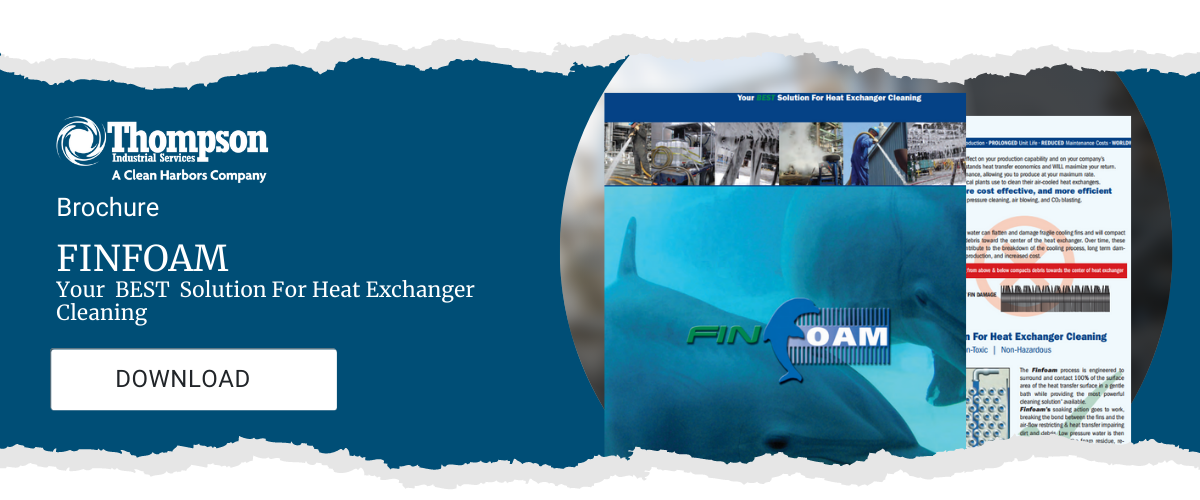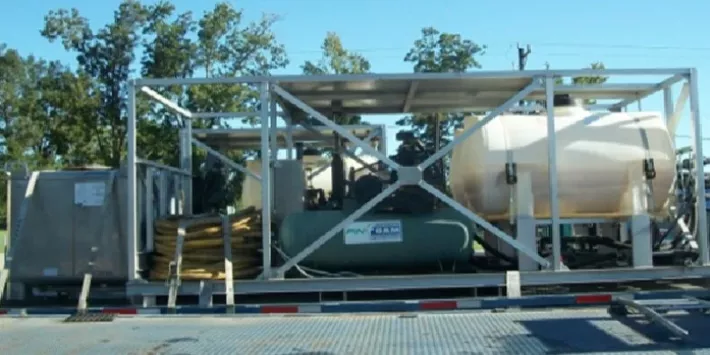Ever since FINFOAM became a division of Thompson Industrial Services, it has been a core service and a favorite among our industrial clients. FINFOAM was originally developed as an environmentally safe, gentle method for removing plugging and debris from air-cooled heat exchanger components.
It’s incredibly effective in that application, and our teams have advanced it further by combining it with another of Thompson’s signature technologies: automated, remotely controlled positioning systems.
The non-toxic, simple nature of FINFOAM makes it surprisingly versatile, and recently our technicians have begun expanding their use of this proprietary application to other types of client projects. In the coming weeks we will be publishing a detailed white paper on these expanded service offerings utilizing FINFOAM, but in the meantime here is a summary of one of the first projects in that category.
As you will see, its success provides us with a strong impetus to explore other ways that this amazing system can benefit our clients!
- Petrochemical Plant Equipment
- A Stop-Gap Cleaning Effort
- Results Surpassing Expectations

Petrochemical Plant Equipment
The story of this unusual project began with a request from a petrochemical plant related to a furnace at a Gulf Coast ethylene plant. The furnace’s efficiency and effectiveness had dropped well below optimal levels, and extensive research into the root causes finally revealed that the tubes in the convection section of the furnace were heavily contaminated with debris.
While plant managers presumed that this debris buildup was the primary cause for the furnace’s poor performance, they also came to the conclusion that replacement of the convection section would be necessary since it had been in operation for nearly 20 years.
A Stop-Gap Cleaning Effort
The petrochemical plant engaged Thompson’s FINFOAM division to use its proven system, normally applied to air-cooled heat exchanger components, to attempt a cleaning of the tubes. The hope was that this cleaning approach would remove enough debris to bring the convection section up to acceptable levels of efficiency until the entire section could be replaced.
The Thompson team quickly built a strategy for cleaning the tubes, which were in a location that posed significant access challenges. Fortunately, the remotely controlled positioners that our teams frequently use with the FINFOAM system made it possible to apply the foaming agent to all surfaces of the tubes without cutting access holes or placing technicians in hazardous situations.
The team was also careful to mitigate the risk of water entering certain areas of the furnace, such as the firebox, during the rinse phase of the FINFOAM process. The planning and execution were highly effective, and it appeared that the cleaning had been successful in removing the built-up debris that had hindered the efficiency of the unit.
Results Surpassing Expectations
When the convection section was brought back online and tests were run to determine the efficiency gains of the FINFOAM cleaning, the results far surpassed the client’s expectations. Rather than simply bringing the performance levels up to minimal acceptable levels, the cleaning had made it possible for the unit to easily exceed the levels required for normal operation.
The client was so confident in the restored power of the furnace’s convection section as a result of treatment with FINFOAM that they decided there was no longer a need to immediately replace the section, instead postponing it to a future phase. In addition, the client expressed an intention of engaging with Thompson for additional cleaning projects at the facility to improve the performance of other furnaces.
Thompson and Innovation
This success story is just one example of the ways that our people here at Thompson Industrial Services constantly examine client needs, compare them with our present technology, and look for ways that we can make our operations do more than ever before.
On a regular basis, we enter situations where an industrial facility’s leadership has become resigned to making do with poorly performing equipment, only to devise a plan that efficiently solves longstanding issues and restores levels of performance that the equipment has not provided in decades.
Please keep an eye on our website and social media for our upcoming full white paper on the use of FINFOAM in alternative settings, and get in touch with us today to arrange a consultation with one of our area experts.

